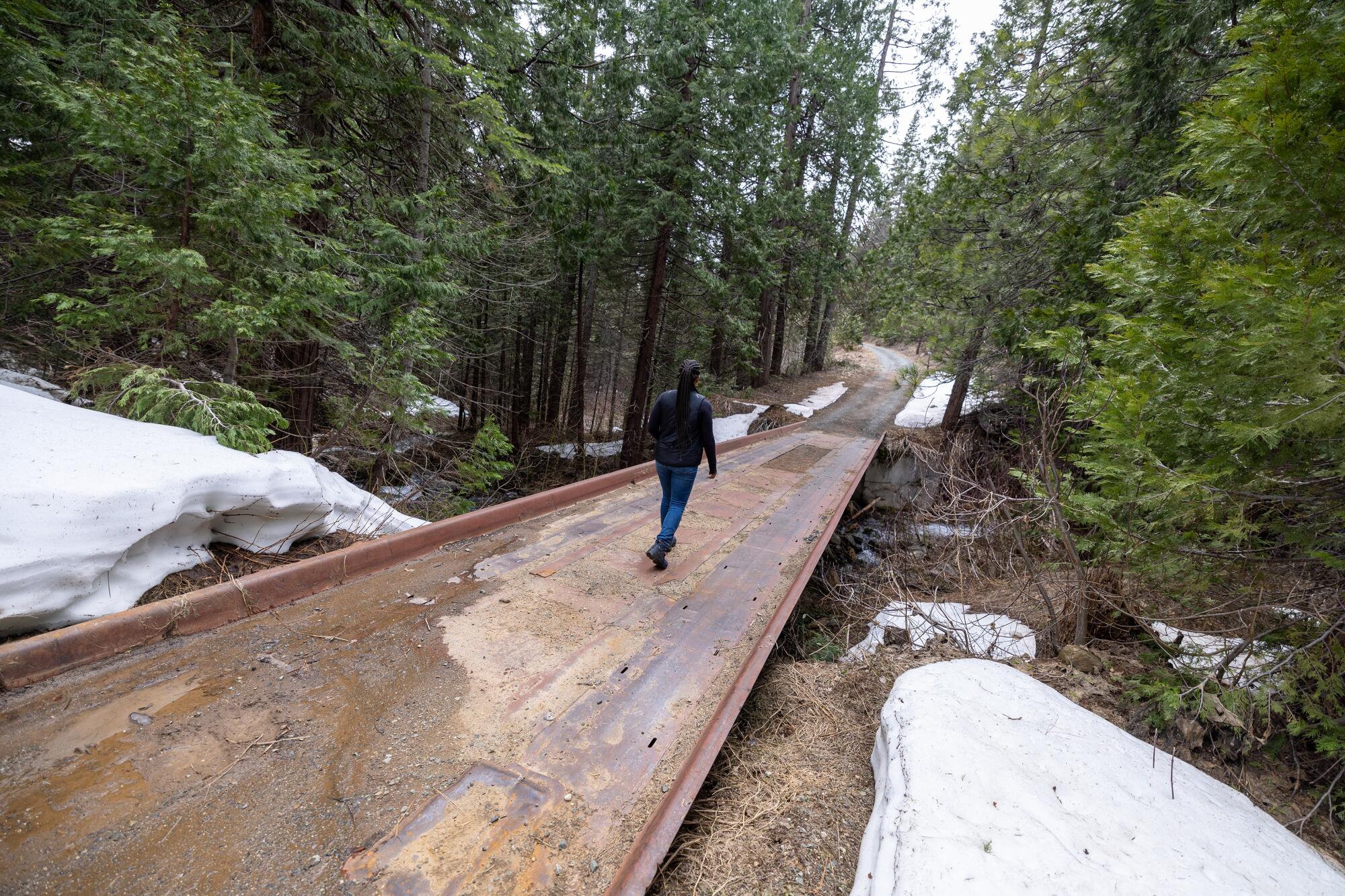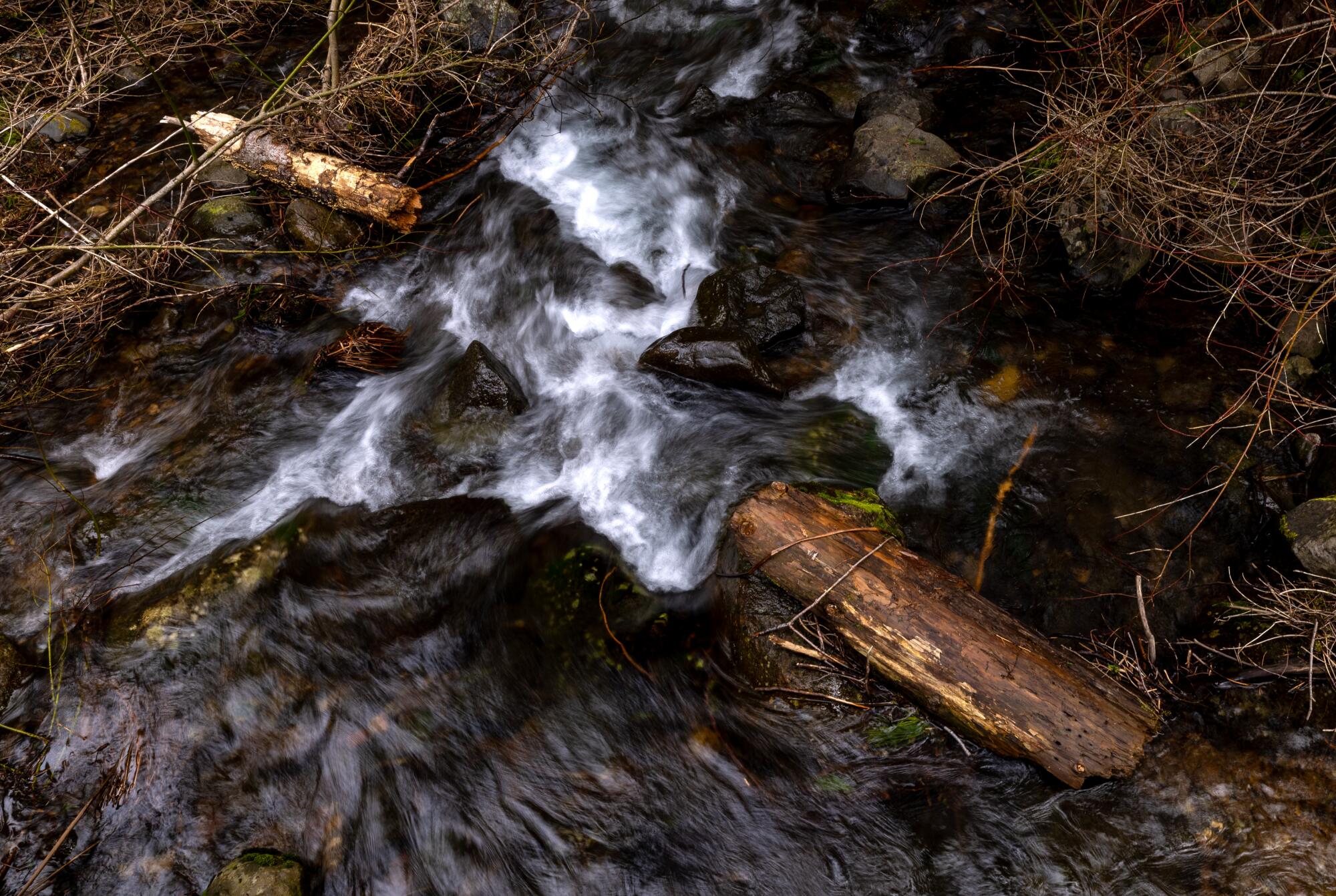Jade Stevens stands on the fringe of a snowy cliff and takes within the jaw-dropping panorama of the Sierra.
Peaks reaching greater than a mile excessive type the backdrop to Bear Valley, a kaleidoscope of inexperienced pastures blended with ponderosa pines, firs, cedars and oak timber.
Stevens, 34, is effectively conscious that a few of her fellow Black Individuals can’t image themselves in locations like this. Tenting, mountain climbing, mountain biking, snow sports activities, venturing to locales with wild animals of their names — these are issues white folks do.
As co-founder of the 40 Acre Conservation League, California’s first Black-led land conservancy, she’s decided to vary that notion.
Darryl Lucien snowshoes close to Lake Putt.
The nonprofit just lately secured $3 million in funding from the state Wildlife Conservation Board and the nonprofit Sierra Nevada Conservancy to buy 650 acres of a former logging forest north of Lake Tahoe. It will likely be a haven for skilled Black out of doors lovers and novices alike.
The land belief, virtually by necessity, has each an environmental and a social mission, Stevens says as she leads a tour of the parcels straddling Interstate 80.
The obvious objective for the property is to assist the state attain a goal of defending 30% of its open area by 2030 — as a part of Gov. Gavin Newsom’s total local weather and conservation initiative.
On condition that Black Individuals traditionally haven’t loved equal entry to nationwide parks and wilderness recreation areas — and have typically been disadvantaged of the prospect to steward giant open areas due to discriminatory land insurance policies — the acquisition carries immense cultural significance too.
The group’s title derives from Union Gen. William T. Sherman’s unfulfilled promise to grant some emancipated slaves “40 acres and a mule” to assist them begin over after the Civil Struggle.
An avid bike owner, Stevens is a part of a rising motion amongst environmentalists, out of doors lovers and naturalists who consider that safeguarding the ecosystem, selling wellness and confronting historic injustices go hand-in-hand.
Though surveys present that Black folks care as a lot about local weather change and defending the setting as different Individuals, these points aren’t essentially high of thoughts in a period when racial strife, police violence and financial inequities command extra consideration.

Lake Putt is the primary attraction among the many the 40 Acre League’s just lately bought parcels.
How will you heed the decision of the wild when life in your individual yard presents so many challenges? Stevens, a advertising and marketing professor at Cal State Dominguez Hills who lives in a traditionally Black neighborhood in Los Angeles — 385 miles to the south — can respect why some would possibly really feel this fashion.
The 70-mile drive from Sacramento, the state capital, appears like a journey to a different dimension, one the place Black folks make up solely about 1% of the inhabitants.
A Trump 2024 signal greets you upon leaving Sacramento’s suburbs and getting into Placer County. Winding previous Gold Rush-era cities, forests and rocky outcroppings, the elevation quickly rises to three,000 toes, 4,000 toes and eventually 5,000 toes.
At Emigrant Hole, Stevens sits on the fringe of Lake Putt and smiles like a girl on high of the world. The lake is the primary attraction among the many conservancy’s parcels and it’s the physique of water motorists see on the appropriate as they head towards Nevada.
The water is so nonetheless you may see an ideal reflection of the snow-capped ridges.

Jade Stevens walks over a bridge in Emigrant Hole.
That is additionally a great spot for Stevens to check all that the 40 Acre group needs to do on this land, from serving to to guard species akin to southern long-toed salamanders and foothill yellow-legged frogs to serving to people who don’t see themselves as nature or wildlife lovers develop a brand new appreciation for California’s fragile ecosystem.
“These vegetation, every thing right here, all of them depend on one another,” she says. “I haven’t introduced my household out right here but, however simply from them seeing what I’m doing, it’s already sparking dialog.”
Trudging in snowshoes alongside Stevens is Darryl Lucien, an legal professional for the 40 Acre group who has acted as a liaison between the nonprofit and officers in native and state authorities.
The land belief isn’t as disconnected from Black Californians as some would possibly suppose, Lucien says.
Subsequent to the lake, a spillway flows right into a stream that the Division of Water Sources refers to as Blue Canyon Creek.

Blue Canyon Creek runs via land just lately bought by the 40 Acre Conservation League, California’s first Black-led land conservancy.
Waters from Blue Canyon Creek finally circulate into the North Fork of the American River, then the Sacramento River, after which the California delta, the place some flows can be channeled into the State Water Challenge, “which finally finds its approach right down to Los Angeles,” Lucien says.
A glance of racial pleasure washes over Lucien, 38, when he contemplates the likelihood that these waters would possibly attain the houses of Black Angelenos.
“Little do they know their water begins on Black land,” he says. “You’re standing on the supply, child.”
It has been lower than a yr since state Assemblymember Mike Gipson, a Democrat from South L.A. County and an early champion of the nonprofit, offered the group with a examine to buy the land. The deliberate habitat restoration will take time, however Stevens already has different large concepts.
Gazing throughout the lake to the southern shore, Stevens sees a location for a nature heart that may maintain environmental schooling courses and double as a rentable lodge for gatherings.
She daydreams about putting in a pier for fishing, lookout factors alongside the shore and grownup treehouses for glamping amongst conifers so tall they don’t slot in a digital camera’s viewfinder.
Simply past the southern shore there are outdated timber-company clearings which might sometime be transformed into trails that hikers can use to succeed in the adjoining Tahoe Nationwide Forest.
“That is an space the place a number of group constructing will happen,” Stevens says. “We’re hoping that everybody finds at the least one factor that makes them really feel welcome on this property.”

The 40 Acre Conservation League has secured $3 million in funding from the state Wildlife Conservation Board and the nonprofit Sierra Nevada Conservancy to buy 650 acres of a former logging space north of Lake Tahoe.
“Welcome” isn’t a phrase that has traditionally greeted Black folks within the nation’s rural areas and wilderness parks, says KangJae “Jerry” Lee, a social and environmental justice researcher and assistant professor within the College of Utah’s Division of Parks, Recreation and Tourism.
Lee notes the irony that the majority Black Individuals descend from enslaved Africans who have been stolen from their homelands particularly for his or her experience in land stewardship and farming. Partaking with the outside was something however a overseas idea.
“A few of them had higher talent units than the European colonists,” Lee says.
Black folks constructed entire cities within the Nice Plains and the West — together with Allensworth, in Tulare County — although many have been overrun by white mobs, seized or suffered decline attributable to an absence of equal entry to assets akin to water.
A few of the first rangers stationed at Yosemite and Sequoia nationwide parks have been Black, but the fact is that the nationwide park system was initially designed as approach for white guests to take pleasure in nature’s splendor, Lee says.
In response, Black-owned resorts catering to an African American clientele sprang up within the early twentieth century — together with in Val Verde, a “black Palm Springs” an hour’s drive north of Los Angeles; at Lake Elsinore close to Riverside; and at Manhattan Beach.
The parks ostensibly welcome all as we speak, however research present that Black Individuals are among the many least doubtless of any racial group to go to them.
“Black folks inherently had a deep, deep connection to the land,” Lee says.”That relationship has been severed over centuries.”
Stevens displays on this painful historical past as she talks concerning the group’s plan to amass different lands all through California, together with open areas nearer to L.A.
Recreation and conservation aren’t the one imperatives at Emigrant Hole.
Stevens pulls out a replica of a handwritten letter she acquired from a Black man from L.A. who’s an inmate at San Quentin. He noticed a TV report concerning the land buy and felt impressed by its mission. He writes about how publicity to nature and recreation will help steer Black and brown teenagers away from gangs and violence, and out of the felony justice system. Stevens agrees.
The property can be a small-business incubator too. The nonprofit intends to assist Black and brown entrepreneurs develop sustainable, outdoor-oriented ventures akin to mountain climbing excursions — fostering generational wealth within the course of.
“How we get again to this fact of appreciating nature, being related to the outside, is our story to inform,” Stevens says.
One native ally needs to assist the group shift the narrative round Black folks and nature — Cindy Gustafson, who sits on the Placer County Board of Supervisors.
Gustafson additionally serves on the Sierra Nevada Conservancy, which awarded the league $750,000 to assist buy the land.

The 40 Acre League’s Jade Stevens, left, and Darryl Lucien stroll alongside an earthen dam at Lake Putt.
Gustafson, who’s white, appreciates the league’s want to assist Northern Californians handle forested lands, which have been devastated lately by lethal and dear wildfires. Fires have grown more and more severe attributable to rising international temperatures, posing a higher threat to flora, fauna and residents in cities and rural areas alike.
“Many people haven’t had the experiences or the background to grasp the character of those forests and the way necessary they’re to our local weather, our surroundings,” Gustafson says. “Having new stewards is actually necessary, as is variety. It’s an indication of hope for me in these divisive instances. … Caring for this land takes us all.”
Stevens appears undaunted by the problem of persuading reluctant Black Californians to view Emigrant Hole as a setting the place they will have fun their tradition whereas studying concerning the ecosystem.
Her pitch is a straightforward one:
“Right here,” Stevens says, “you’re secure.”
Source link








